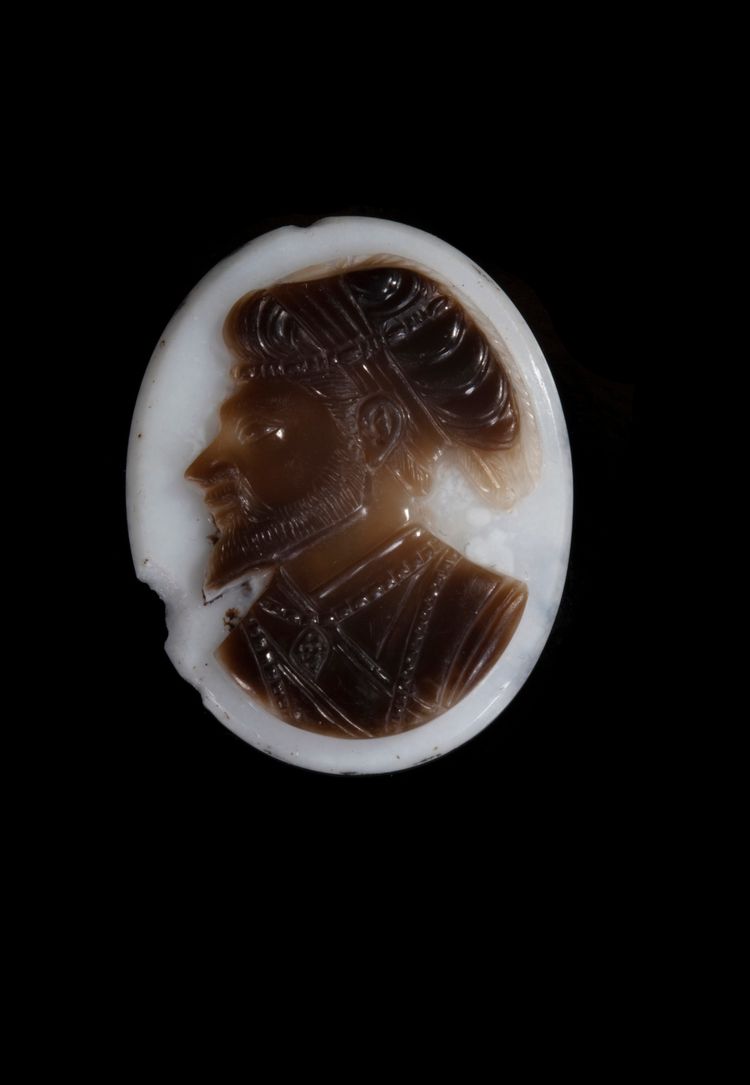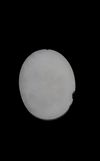A RARE AND IMPORTANT SARDONYX PORTRAIT CAMEO OF THE MUGHAL EMPEROR SHAH JAHAN (REIGNED 1628-58)
Oval shaped, the figure cut from the brown layer of stone, standing out against the white layer marble-like, depicted facing left, wearing elaborate turban with pearls, tunic and jewels.
3 by 2.5 cm.
CATALOGUE NOTE
The other known pieces are in the Victoria and Albert Museum, London (Robert Skelton et al, The Indian Heritage: Court Life and Arts under Mughal Rule, London, 21 April – 22 August 1982, nos. 376); the Bibliotheque Nationale, Paris (Skelton et al, 1982, no. 377) ; the al-Sabah Collection, Kuwait, the latter only coming to light in 1982 (Manuel Keene with Salam Kaoukji, The Treasury of the World: Jewelled Arts of India in the Age of the Mughals, London, 2001, no. 9.11). In summer 1982, two of the three images of Shah Jahan known at the time were exhibited at the Victoria and Albert Museum exhibition, The Indian Heritage: Court Life under Mughal Rule (Skelton et al, 1982, nos. 376-7).
The Indian Heritage exhibition catalogue suggested that this small group of cameos was made or derived from the work of European craftsmen working at the Mughal court (Skelton et al., 1982, p. 123). European travellers mention a number of French and Italian lapidaries at the courts of Jahangir and Shah Jahan, but no actual name is recorded (E. Babelon, Catalogue des camees antiques et modernes de la Bibliotheque Nationale, Paris, 1897, I, pp. 197-8, no. 366, II, pl. XLII).
A cameo is a carving from a stone of two or more parallel layers of contrasting colours. The head or figure to be worked is cut in one layer, and the contrasting colour serves as a background. Typical stones used for cameos include black and white onyx, sardonyx, carnelian onyx, and onyx jasper. (Francis J. Sperisen, The Art of the Lapidary, Milwaukee, 1950, p. 300). In this case, the material is sardonyx with a white ground, perhaps reflecting the taste for white ground enamel in jewelled objects at this time.
The art of hardstone carving in India dated back to prehistory; most surviving hardstone carvings, however, belong to the Mughal period (1526-1858). In the tradition of Muslim courts, Shah Jahan was trained in the art of hardstone carving and during this reign, the quality of hardstone carving reached its zenith, the finest surviving example from the period being Shah Jahan’s own wine cup that is now in the Victoria and Albert Museum, London (Skelton et al, 1982, no. 356); on a larger scale, the emperor’s interest is reflected in the extraordinary pietra dura panels on the Taj Mahal, the mausoleum Shah Jahan built for his beloved wife, Mumtaz Mahal.
This cameo is notable not only because of its rarity, but for the quality of its carving, the stone being used to its maximum effect by carving and polishing techniques contrasting fine details such as the smooth texture of the skin with the matt of his beard. The image depicts Shah Jahan later in life and is a rare image of majesty in-keeping with the European tradition at the time. The very nature and small scale of this piece, which would have been the ultimate in luxury items, suggest that it may have been commissioned by the emperor himself or a high-ranking official at the Mughal court.


